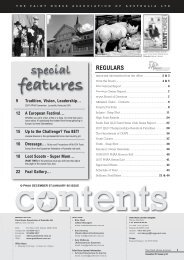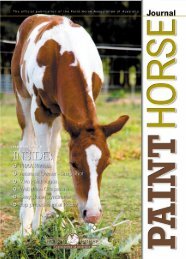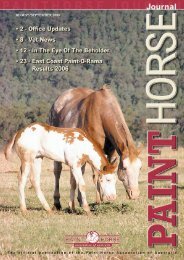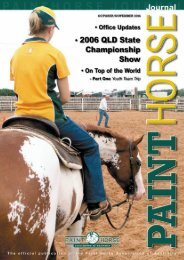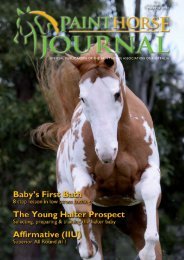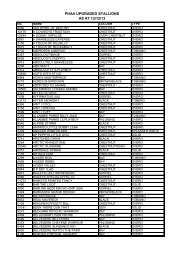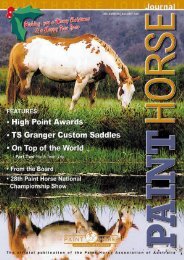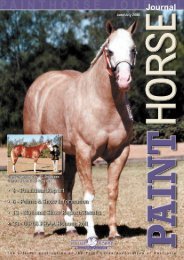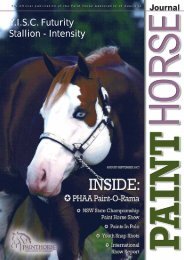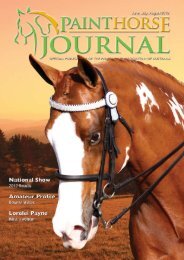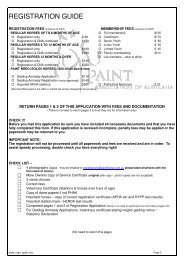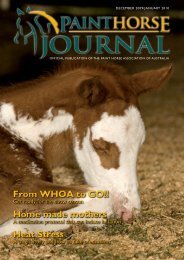Acres of Clover ⢠Photo by: Stefan & Barbara Wielebinski
Acres of Clover ⢠Photo by: Stefan & Barbara Wielebinski
Acres of Clover ⢠Photo by: Stefan & Barbara Wielebinski
You also want an ePaper? Increase the reach of your titles
YUMPU automatically turns print PDFs into web optimized ePapers that Google loves.
which colors any given horse can (or cannot) produce, and<br />
at what frequency.<br />
The variety <strong>of</strong> colors and patterns which occur in horses<br />
are produced <strong>by</strong> interactions <strong>of</strong> one <strong>of</strong> the base colors with<br />
additional modifying genes and alleles. Most <strong>of</strong> them are<br />
dominant and include several dilution genes (such as<br />
Cream, Dun, Silver, Champagne, Pearl), or genes<br />
determining the presence <strong>of</strong> white hair, which can be<br />
distributed diffusely throughout the coat (Grey, Roan), or as<br />
distinctive spots (Tobiano, Overo, Sabino, Appaloosa). As<br />
these colors and patterns are caused <strong>by</strong> alleles in separate<br />
genes, combinations <strong>of</strong> two or more <strong>of</strong> them can occur in<br />
the same horse.<br />
Regarding white spotting, I believe that it is worth<br />
mentioning the most consequential mutation which is the<br />
Lethal White Overo (LWO) causing the Lethal White Foal<br />
Syndrome in LWO/LWO homozygotes. In carriers (=<br />
heterozygotes carrying one LWO allele), this mutation if<br />
frequently associated with the frame overo pattern, but the<br />
expression can vary widely, ranging from a loud overo to a<br />
solid colored individual. LWO mutation is found across<br />
various breeds - not just Paints and Pintos.<br />
If there is the slightest chance <strong>of</strong> a horse carrying LWO, it<br />
is a good practice to test for it, to avoid unintentional mating<br />
<strong>of</strong> two carriers, which would have a 25% calculated risk <strong>of</strong><br />
producing an affected white LWO/LWO homozygote.<br />
While the primary focus <strong>of</strong> horse breeders is the<br />
improvement <strong>of</strong> conformation and performance, the<br />
diversity <strong>of</strong> coat colors and spotting patterns can also play<br />
an important role. From the described facts it is clear that<br />
DNA testing combined with the understanding <strong>of</strong> basic<br />
genetic rules can enable breeders to make informed<br />
decisions about which horses to mate to maximize the<br />
production <strong>of</strong> desired colors and patterns. Furthermore,<br />
DNA testing can be also critical to determine the true color<br />
<strong>of</strong> a horse, thus facilitating its correct registration. ✪<br />
* DNA TESTING *<br />
HORSES – DONKEYS – DOGS – BIRDS (Sexing)<br />
.…………………………………….<br />
PET DNA SERVICES OF AZ®<br />
www.petdnaservicesaz.com<br />
Michal Prochazka, MD, Founder & Director<br />
genes@petdnaservicesaz.com<br />
602-380-8552 (TEL) • 480-968-6817 (FAX)<br />
PO Box 7809, Chandler, AZ 85246, USA<br />
2008 STATE SHOW<br />
VPHA presents the<br />
2008 Victorian State Championships<br />
&<br />
Triple Judge All Breeds Spectacular<br />
Saturday 19th and Sunday 20th <strong>of</strong> April 2008<br />
Werribee Park National Equestrian Centre<br />
Lead Judge Saturday & State Show Judge: Interstate Judges<br />
Over 30 Gist buckles to be won <strong>by</strong>:<br />
• Grand Champion Halter Exhibits<br />
• Futurities<br />
• High Point Performance<br />
Program available on the website February 11th 2008 - www.vpha.com.au<br />
Contact:<br />
The President: Sue Sparkman - 0400 811 145<br />
The Secretary: Claire Geri - 0448 335 479<br />
<strong>Photo</strong>s <strong>by</strong>: Audrey Haywood<br />
The Paint Horse Journal 33<br />
April/May 2008



